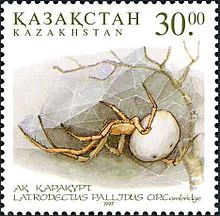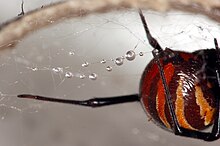Real widows
| Real widows | ||||||||||||
|---|---|---|---|---|---|---|---|---|---|---|---|---|

European black widow |
||||||||||||
| Systematics | ||||||||||||
|
||||||||||||
| Scientific name | ||||||||||||
| Latrodectus | ||||||||||||
| Walckenaer , 1805 |
As True Widows ( Latrodectus ) is a genus of spiders of the family of theridiidae referred (Theridiidae). It includes 31 species, including the "black widows", which are endowed with particularly strong poisons.
Well-known species of the genus include the globally occurring brown widow ( Latrodectus geometricus ), the white widow ( Latrodectus pallidus ), which is widespread from West Africa to Central Asia , the red-backed spider ( Latrodectus hasselti ) native to Australia and New Zealand and the southern black widow found in North America ( Latrodectus mactans ). In the past, a number of black-colored species were grouped together as "black widows" ( Latrodectus mactans in the broader sense), but in 1970 these were divided into individual species according to their geographical distribution area. The European black widow ( Latrodectus tredecimguttatus ), which is native to southern Europe, North Africa and Central Asia as far as China, was also previously regarded as a subspecies of the North American black widow, but is now considered a separate species under the scientific name Latrodectus tredecimguttatus .
description

In North America, United States from southern New England to Florida, also widespread in much of Central and South American black widow spider (Black Widow) L. mactans is black and carries on the ventral side of a red drawing. The species Latrodectus tredecimguttatus , which occurs in southern Europe around the Mediterranean Sea, on the Atlantic Islands, in southern Russia, Southeast Europe, North Africa, Asia Minor and Central Asia and in large parts of Africa and Asia, has a similar pattern and also has thirteen red to orange spots on its back. This is where its Latin name comes from, because tredecimguttatus means "thirteen spotted". The genus also includes other species , some of which live in the same range and are therefore sometimes also referred to as black widow. The white widow ( Latrodectus pallidus ) is the only species of the genus that has a light basic color.
The females are about 9 to 15 mm long.
Naming
The name real widows comes from the observation that the females eat the smaller male after mating and thereby make themselves a "widow". However, this behavior, which can also be observed in most other spiders, is not the norm in true widows. The encounter with the female is fatal for the male only in around 12.5% of the cases.
The real widows (genus Latrodectus ) are contrasted with the representatives of the genus Steatoda , the "false widows". These are similar in body shape to the real widows, but are not that dangerous. In German, the Steatoda species are usually referred to as fat spiders . Only the species Steatoda paykulliana , which is similar to the European black widow ( Latrodectus tredecimguttatus ) and occurs in the same Mediterranean distribution area, is called a false widow . There are also fat spiders on other continents that can be confused with real widows. In New Zealand, for example, the fat spider Steatoda capensis , which is introduced from South Africa and resembles a native widow spider, the red katipo ( Latrodectus katipo ), is referred to as "false katipo".
The Germanized name "Malmignatte" appears very often. It is derived from the Italian trivial name "Marmignatto", which the entomologist Pietro Rossi also mentions in his first description of the European Black Widow in 1790. In 1837 Charles Athanase Walckenaer described a Latrodectus malmignatus in his Histoire naturelle des insectes , which is identical to the previously described Latrodectus tredecimguttatus , the European black widow. Usually the Germanized name “Malmignatte” refers to the European type of black widow, but the term is also applied to types of black widows that live on other continents.
In the southern Russian and Central Asian distribution area of the European black widow, the common name Karakurt , Germanized Karakurte, is used, which means "black wolf".
Reproduction
In Latrodectus hasselti , the male is often injured during copulation. The female's bite can cause the hemolymph to leak and thus a drop in hemolymph pressure, which may cause a. is needed for movement. If the bite wound is too big, it can lead to the death of the male. Since the female has two spermatheks , the death of the male after the first copulation would promote genetic diversity, since a second male would also be given the chance to be fertilized.
On the other hand, survival of the male increases the chance of fatherhood through a second copulation by more than 50%. Males react to the bite by constricting the injured part of the abdomen, thereby surviving and increasing their endurance and copulation success during the second copulation. The sperm of males who copulate a second time are more likely to be responsible for fertilization. There is thus a paradoxical selection process in the development of the species: males that have already been bitten by copulation and survived can reproduce more successfully.
In the case of another species, Indicoblemma lannaianum , it has been shown that the female can quasi “choose” the fitter partner as father after copulation. There are similar indications of selection by the female, for example, with the females of the trembling spiders , who break off courtship with unsuitable males.
Bite accidents
To catch their prey, usually insects, members of the genus spin a net of a hood . The "black widow" prefers to move to dark and cool places, which is why they can also be found in human dwellings, for example in cellars or sheds.
Although the animals are not aggressive, there are nonetheless, albeit rare, bite accidents with people, which can have serious consequences for children and sick or weak people. Most black widow bite accidents in the United States occur in outside toilets, where the spiders spin their hooded web under the toilet seat to lie in wait for the insects attracted by the fecal smell . If a person sits carelessly on the glasses , a poison bite can occur.
In most cases, the bite itself is not painful and often goes unnoticed. In 90 percent of cases that causes toxic mixture with the main component α-latrotoxin the symptom , a strong abdominal pain, accompanied by sweating. Those affected often described the pain as unbearably severe. The sweating of the skin at the bite site is an important diagnostic criterion . An itchy rash will develop after a few days. In severe cases, sleep disorders, high blood pressure and cramps can occur. Usually those bitten recover after a few days, but deaths, for example due to severe pulmonary edema , have also occurred. In the literature it is noted that before the introduction of serum therapy the mortality rate was five percent, since then it has been around 0.2 percent.
species
There are no populations in Germany. At the beginning of 2009, a female L. mactans was found on cargo items from Chicago in Groß-Gerau , Hessen , but it was presumably introduced. In Belgium and France there are populations of introduced and runaway species ( L. geometricus , L. mactans ).
North American species
- Latrodectus bishopi , Red Widow, Florida, USA
- Latrodectus hesperus , Western Black Widow, Western Canada, United States, and Mexico. Also occurs in Israel.
- Latrodectus mactans , Southern Black Widow (often just called Black Widow), warm regions of the USA.
- Latrodectus variolus , Northern Black Widow, from extreme southeast and southern Canada to northern Florida, increasing in frequency as it moves north.
Species from Central and South America
The following species are native to Central and South America:
- Latrodectus antheratus , Paraguay, Argentina
- Latrodectus apicalis , Galapagos Islands
- Latrodectus corallinus , Argentina
- Latrodectus curacaviensis , Lesser Antilles, South America
- Latrodectus diaguita , Argentina
- Latrodectus mirabilis , Argentina
- Latrodectus quartus , Argentina
- Latrodectus thoracicus , Chile
- Latrodectus variegatus , the Chilean widow, Chile and Argentina
Species in Europe, North Africa, the Middle East, and Western Asia
- Latrodectus dahli , Middle East to Central Asia
- Latrodectus hystrix , Yemen, Socotra
- Latrodectus lilianae , the Iberian widow, Iberian Peninsula
- Latrodectus pallidus , the white widow or white steppe spider, North Africa, Middle East, Russia, Iran, Central Asia, Cape Verde Islands
- Latrodectus revivensis , Israel
- Latrodectus tredecimguttatus , the European black widow (or Mediterranean black widow), Mediterranean areas, Central Asia. Also found in China. Some biologists also refer to this as Latrodectus lugubris .
Species of the Sub-Sahara and Madagascar
- Latrodectus cinctus , Southern Africa. Also found in the Cape Verde Islands and Kuwait.
- Latrodectus indistinctus , South Africa and Namibia
- Latrodectus karrooensis , Southern Africa
- Latrodectus menavodi , Madagascar, Comoros, Aldabra
- Latrodectus obscurior , Cape Verde, Madagascar
- Latrodectus renivulvatus , Africa, also in Saudi Arabia and Yemen.
- Latrodectus rhodesiensis , Zimbabwe.
Species in south, east and southeast Asia
- Latrodectus elegans , China, Myanmar, Japan
- Latrodectus erythromelas , Sri Lanka
Species in Australia and Oceania
- Latrodectus katipo , the red katipo, is native to New Zealand .
- Latrodectus hasselti , the red-backed spider, originally native to Australia, was introduced in New Zealand and in Southeast Asia to Japan.
Worldwide occurring species
- Latrodectus geometricus , the brown button spider . The original home of the spider is unclear, as it is found in many warm regions of the world.
literature
- Herbert W. Levi: The spider genus Latrodectus (Araneae, Theridiidae) . Transactions of the American Microscopical Society, 78, 1, pp. 7-43, 1959
- Raymond W. Thorp and WD Woodson: Black Widow: America's most poisonous spider , Chapel Hill, North Carolina, 1945
- Raymond W. Thorp and WD Woodson: The black widow spider , Dover Publications, New York 1976, ISBN 0-486-23405-3
- Sergio Bettini: Epidemiology of latrodectism , Toxicon 2: 93-102, 1966
- Sergio Bettini and M. Maroli: Venoms of Theridiidae, genus Latrodectus , Arthropod Venoms; Handbook of Experimental Pharmacology, Vol. 48, Springer Verlag, New York 1978, ISBN 0-387-08228-X
- Günter Schmidt: Poisonous and dangerous arachnids , Westarp Sciences, Hohenwarsleben 2000, ISBN 3-89432-405-8
Web links
Real widows in the World Spider Catalog
- Australian Museum Online: Redback Spider
- Link collection of the International Society of Arachnology
- Pictures of taxonomically important characteristics of Latrodectus sp., Information on keeping breeding
Individual evidence
- ^ Norman I. Platnick: The World Spider Catalog, Version 10.5. American Museum of Natural History, 2000-2010 Family Theridiidae, genus Latrodectus
- ↑ Rainer F. Foelix: Biology of the spiders. Georg Thieme Verlag, Stuttgart 1979 ISBN 3-13-575801-X
- ↑ Maydianne CB Andrade, Lei Gu, Jeffrey A Stoltz: Novel male trait prolongs survival in suicidal mating . In: Biology Letters . 1, No. 3, September 22, 2005, pp. 276-279. PMC 1617149 (free full text). doi : 10.1098 / rsbl.2005.0318 .
- ↑ M. Burger et al .: Complex genital system of a haplogyne spider (Arachnida, Araneae, Tetrablemmidae) indicates internal fertilization and full female control over transferred sperm. Journal of Morphology, 267, 2, pp. 166-186, 2005, doi : 10.1002 / jmor.10394 (Eng.)
- ↑ Toxicological evaluation of bites in the Toxinfo database
- ↑ Peter Jäger (2009): Latrodectus mactans introduced to Germany. Arachnologische Mitteilungen 35, pp. 35–38. ( Online ; PDF; 171 kB)
- ↑ Handbook of Clinical Toxicology of Animal Venoms and Poisons Es, Exact Solutions, and Conservation Laws, by Jurg Meier and Julian White, 1995 edition, ISBN 0-8493-4489-1



